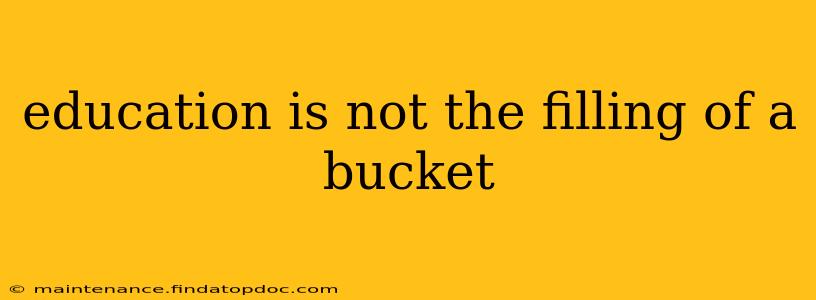The famous quote, "Education is not the filling of a bucket, but the lighting of a fire," attributed to William Butler Yeats (though its exact origin is debated), speaks volumes about the true essence of learning. It challenges the traditional, passive model of education where students are seen as empty vessels to be filled with information. Instead, it proposes a transformative process—one that ignites curiosity, fosters critical thinking, and empowers individuals to become lifelong learners. This article delves deeper into this powerful metaphor, exploring its implications and examining what truly constitutes meaningful education.
What Does "Filling a Bucket" Represent in Education?
The "filling a bucket" analogy represents a rote learning approach, prevalent in many traditional educational systems. This method focuses on memorization and the regurgitation of facts without necessarily understanding their context or application. Students passively receive information, often through lectures and textbooks, with the primary goal of achieving high grades on tests. While knowledge acquisition is important, this approach often fails to cultivate genuine understanding, critical thinking skills, or a passion for learning.
What Does "Lighting a Fire" Represent?
"Lighting a fire" signifies a more active and engaging learning process. This approach emphasizes:
- Critical Thinking: Students are encouraged to analyze information, question assumptions, and form their own conclusions. It's about understanding why something is true, not just that it's true.
- Creativity and Innovation: Education becomes a platform for exploring ideas, fostering creativity, and developing innovative solutions to problems.
- Curiosity and Exploration: Learners are driven by an intrinsic desire to learn and explore new subjects and perspectives. The learning process becomes an adventure, not a chore.
- Lifelong Learning: The "fire" represents a passion for learning that burns long after formal education ends. Individuals become self-directed learners, constantly seeking knowledge and growth.
How Can We Shift from "Filling Buckets" to "Lighting Fires"?
The shift from passive to active learning requires a fundamental change in pedagogical approaches. Here are some key strategies:
- Inquiry-Based Learning: Encourage students to ask questions, explore their own interests, and design their own learning experiences.
- Project-Based Learning: Engage students in complex projects that require them to apply their knowledge and skills to real-world problems.
- Collaborative Learning: Foster a sense of community and shared learning through group projects, discussions, and peer teaching.
- Experiential Learning: Provide opportunities for students to learn through direct experience, such as field trips, internships, or volunteer work.
- Personalized Learning: Tailor instruction to meet the individual needs and learning styles of each student.
What are the Benefits of "Lighting a Fire" Approach?
The "lighting a fire" approach yields numerous benefits:
- Increased Engagement and Motivation: Students are more actively involved in their learning and are more likely to retain information.
- Improved Critical Thinking Skills: Students develop the ability to analyze information, solve problems, and make informed decisions.
- Greater Creativity and Innovation: Students are empowered to think outside the box and develop innovative solutions.
- Enhanced Lifelong Learning: Students develop a passion for learning that extends beyond formal education.
Is Rote Learning Completely Useless?
While rote learning has its limitations, it's not entirely without value. Certain foundational knowledge requires memorization, such as basic arithmetic facts or historical dates. The key is to find a balance between rote learning and deeper, more meaningful understanding. Rote learning should serve as a foundation upon which to build critical thinking and problem-solving skills.
How Can Parents Support the "Lighting a Fire" Approach?
Parents play a crucial role in supporting their children's learning. They can:
- Encourage curiosity: Ask open-ended questions and foster a love of exploration.
- Provide opportunities for learning: Visit museums, libraries, and other educational venues.
- Support independent learning: Encourage children to pursue their own interests and explore subjects that fascinate them.
- Value effort over grades: Emphasize the importance of learning and personal growth over achieving high grades.
In conclusion, shifting from "filling a bucket" to "lighting a fire" requires a fundamental change in our approach to education. By fostering critical thinking, creativity, curiosity, and lifelong learning, we can empower individuals to reach their full potential and become active, engaged citizens of the world. This transformative approach to education is not merely about acquiring knowledge; it's about igniting a passion for learning that lasts a lifetime.
